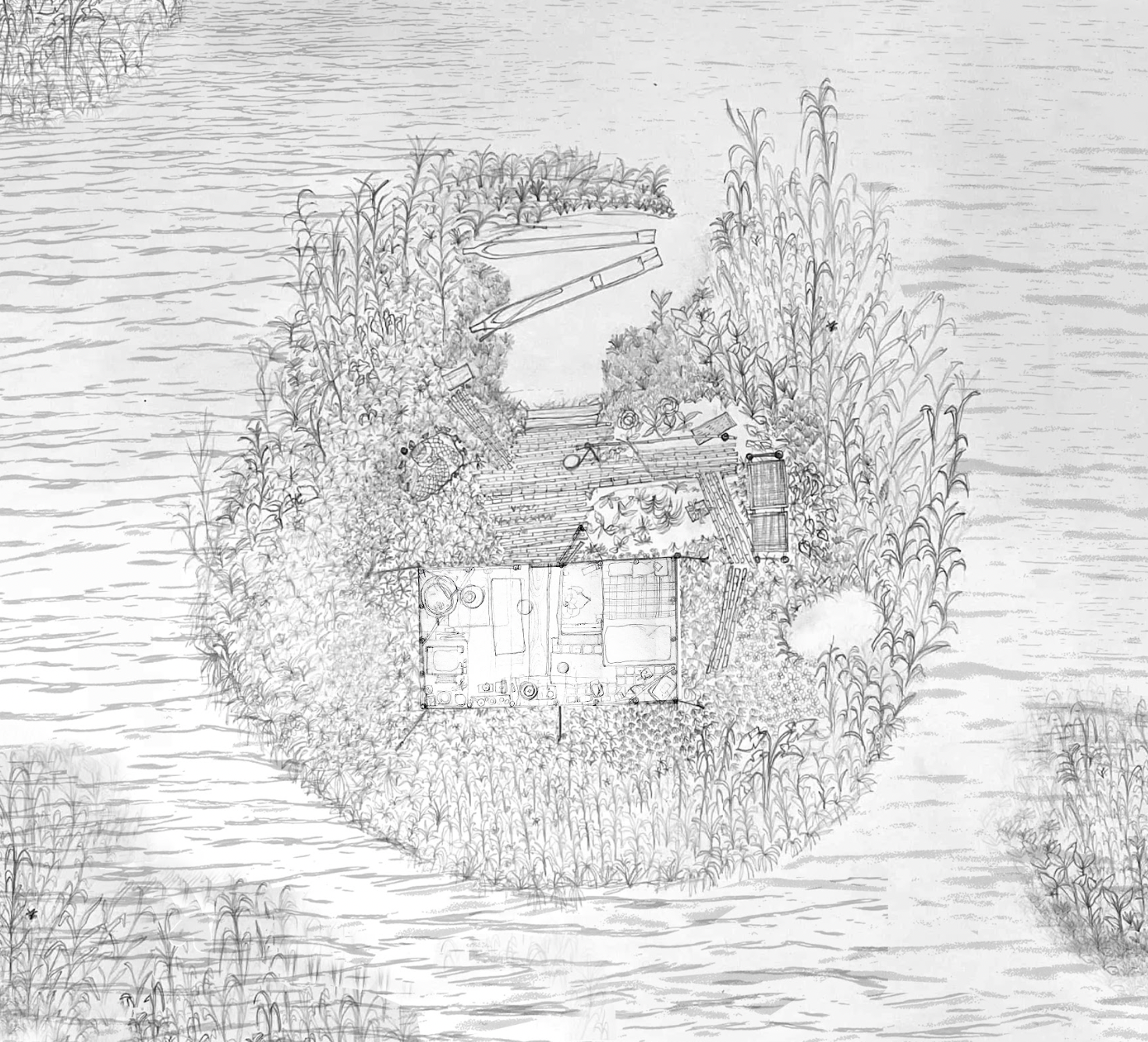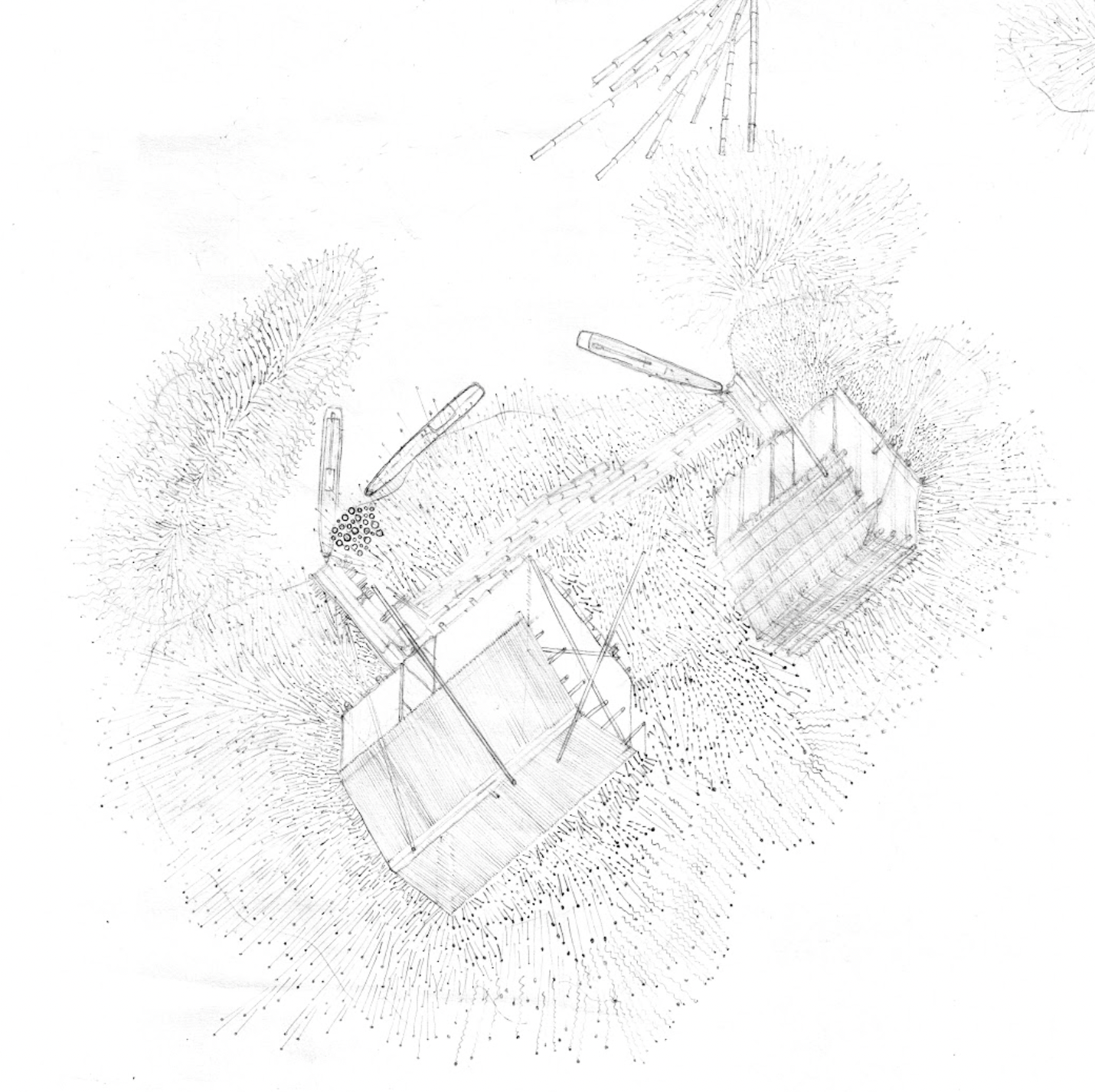
Sem 06 | Settlement Studies
Environmental Conditions, Ground, and Built Form - 2
Dipti Bhaindarkar and Aakansha Shah
After two long years of restricted movement in the city, COVID pandemic receded providing us with much needed opportunity to physically enter into a field to experience, to engage, and to inhabit a new ground. 2022, Third Year students of SEA entered unknown waters of Loktak lake in Manipur. We flew to Imphal from Mumbai on a crisp summer morning. From 33,000ft above, the view was breathtaking-roads, buildings, fields everything seemed like lines, toys. As we approached closer to the destination, the pulsating Loktak Lake spread beneath us - The water bowl that feeds from several rivers of the state of Manipur. Numerous masses of vegetation adorned the water body. Little did we know that these were floating islands that sailed along with winds, almost like clouds hovering in the sky.
All giggly and cracking, we entered the motor boat that navigated us to the heart of the lake. While the glassy waters reflected the soft blues of the sky, the bottom glowed with vegetation. Floating on the surface were several phumdis onto which fishermen built their homes and practiced fishing for a living. Here, the idea of land title was skewed. Kinship, or rather friendship is what held together the mass and its people. It was a landscape of acquaintances!
The phumdi was a sailing continuum of varying depths. One could feel the wetness as water seeped upwards to moisten the feet at thinner regions more like a sponge, while the thick portions were more stable. It was a curated garden-tall grass at the edge swayed along with the winds and a radial growth of delicate, edible plants surrounded the house. Cats were frequent visitors. At places the rhythm of the island was further elaborated by capillary like ingress, almost as if water made its way to reach the field!
At times, a gust of wind caused the islands to drift away followed by instances where the wind was completely non-existent and everything stood still. As if the roar of the wind gave way to warmth and quiet to feel the essence of each moment. Hence, the move causes stability and the map changes each time! The idea of time was important here. Although slow, it was the guiding factor to their practice of livelihood- the routine was informed by what time of the year it is and which fish they would be able to fetch. Narrow, ring-like biomass called the Phum was developed for large scale fish farming during winters.
All giggly and cracking, we entered the motor boat that navigated us to the heart of the lake. While the glassy waters reflected the soft blues of the sky, the bottom glowed with vegetation. Floating on the surface were several phumdis onto which fishermen built their homes and practiced fishing for a living. Here, the idea of land title was skewed. Kinship, or rather friendship is what held together the mass and its people. It was a landscape of acquaintances!
The phumdi was a sailing continuum of varying depths. One could feel the wetness as water seeped upwards to moisten the feet at thinner regions more like a sponge, while the thick portions were more stable. It was a curated garden-tall grass at the edge swayed along with the winds and a radial growth of delicate, edible plants surrounded the house. Cats were frequent visitors. At places the rhythm of the island was further elaborated by capillary like ingress, almost as if water made its way to reach the field!
At times, a gust of wind caused the islands to drift away followed by instances where the wind was completely non-existent and everything stood still. As if the roar of the wind gave way to warmth and quiet to feel the essence of each moment. Hence, the move causes stability and the map changes each time! The idea of time was important here. Although slow, it was the guiding factor to their practice of livelihood- the routine was informed by what time of the year it is and which fish they would be able to fetch. Narrow, ring-like biomass called the Phum was developed for large scale fish farming during winters.
The homes were careful assemblies of bamboo, thatch and/or GI sheets which demarcated a space of living. The periphery was crafted by these objects that found place in niches and platforms while the center was a void frequented by people for sleeping, having meals or even simply sitting. The house was filled with the smell of fresh fish after a good catch and meant a sumptuous meal for the day. The stark contrast amidst porosity and impermeability was evident with all storage materials resisting wetness while the wooden floor still felt like a scented moist surface.Gazing at the moving masses through the door was probably the kind of leisure they pursued, unlike the city dwellers who built elaborate infrastructure for recreation. The home extended beyond the enclosure and thereby included the lake and fishing masses which formed the ecosystem.
Long, slim wooden boats captained by a fishermen or woman with a single paddle drifted out onto the water carefully checking fishing nets set by floating phumdis. These were stable and wobbly at the same time. While the fishermen had found the perfect balance, we feared that the boat would topple. Although this boat ride in the vast expanse of the lake felt surreal. The horizon was the only line, the rest was just so delicately intertwined with one another that it almost blurred the idea of a threshold. From here, one could merely see the roofs from a distance amidst tall grasses. We came to understand that only a few bamboo members touched the soft bed and anchored the smaller mass that held another phumdi with a tie.
Extending, thickening the biomass were everyday practices of the fisher people which crafted the dynamism of the lake. It breathes with these small interventions and without its people the garden would stagnate. It was a canvas painted by the locals year by year, one day at a time. The largest freshwater lake is one of its kind.
We traced the shifts, the drifts, the movements and the anchors as we learnt the story of the home that floats on the lake.
Long, slim wooden boats captained by a fishermen or woman with a single paddle drifted out onto the water carefully checking fishing nets set by floating phumdis. These were stable and wobbly at the same time. While the fishermen had found the perfect balance, we feared that the boat would topple. Although this boat ride in the vast expanse of the lake felt surreal. The horizon was the only line, the rest was just so delicately intertwined with one another that it almost blurred the idea of a threshold. From here, one could merely see the roofs from a distance amidst tall grasses. We came to understand that only a few bamboo members touched the soft bed and anchored the smaller mass that held another phumdi with a tie.
Extending, thickening the biomass were everyday practices of the fisher people which crafted the dynamism of the lake. It breathes with these small interventions and without its people the garden would stagnate. It was a canvas painted by the locals year by year, one day at a time. The largest freshwater lake is one of its kind.
We traced the shifts, the drifts, the movements and the anchors as we learnt the story of the home that floats on the lake.

